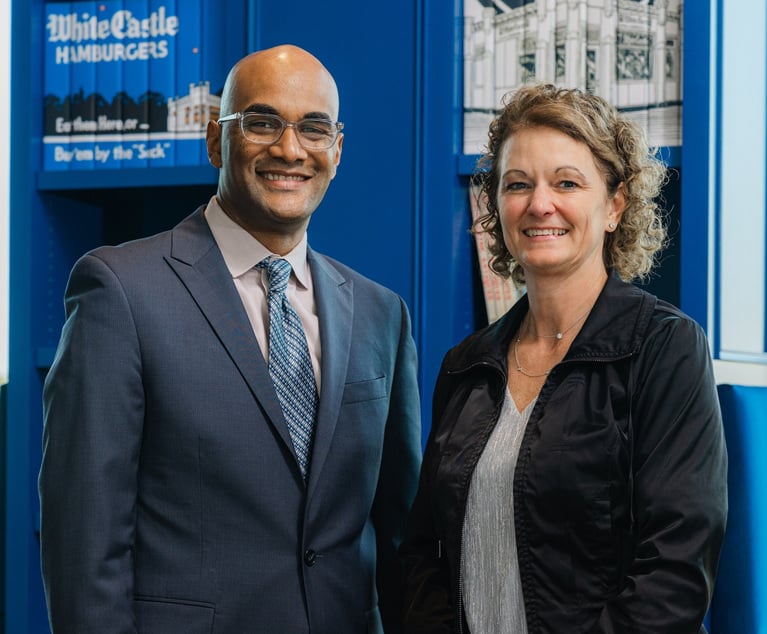9 tips for giving great panel presentations
Good panels need strong moderators, preparation and frank, heartfelt dialogue.
September 19, 2011 at 07:44 AM
7 minute read
The original version of this story was published on Law.com
September is the beginning of conference season, and in-house counsel often are asked to speak on panels at legal conferences or other industry functions. Having both organized and participated in many panels, plus having watched many, many more, I've had an opportunity to see what works.
- Panels are a form of presentation: Panels are a form of shared presentations. Tips from my previous column on effective presentations apply.
- Choose your format, don't let it choose you: Panels can follow many different formats, including consecutive panelist presentations, round robin, all Q&A, point-counter point and—my personal preference—a shorter presentation deck with each slide being presented and commented on by different panel members. The best format depends on your intended content and panel makeup. The group should discuss and pick the best format.
- Build your story through an outline: Like all good presentations, the collective content of good panels also tell a story. Don't start by throwing some slides tougher. First create a high-level outline assigning different topics to each panelist. Note that not all panels need slides.
- Create twice the needed content, then halve it: Create twice as much content and twice as many slides as you need. Then let it rest. Shortly before the slides are due, pick the best half of your material and delete the rest. Be brutal. If it's not really good content, cut it out.
- Encourage a strong moderator: Often panels are composed of people who may not know each other well and there is a natural reluctance for anyone to appear too pushy. Nevertheless, panels need a strong moderator. I saw one panel where the first panelists spoke for nearly the entire session, giving the other panelists almost no time to speak. When I'm acting as a moderator, I tell my panel that my job is to watch the time and I apologize in advance that I may interrupt them. Poor is the moderator who uses their role to dominate the discussion.
- Tighten up ramblings with key questions: The moderator's other main role is to tighten up the conversation. There is a tendency to ramble in panels. A good moderator or fellow panelists will inject key questions at the right time: “I hear what you are saying, but how do you really make this work in your legal department?,” drawing out interesting content.
- Include the audience: Good panels include the audience in the discussion. I like to encourage questions throughout the presentation. If things run off track, the moderator can always bring the session back on target. A lot of questions make a lively discussion.
- Keep track of time: I always like to divide the total amount of time available by the number of slides, keeping in mind that panel discussions go through slides at a much slower pace than solo presentations. (Nine minutes per slide is a good metric.) This helps avoid running out of time before the final slides and guides how long to keep the questions flowing. My chart keeps things on track.
- Speak from the heart: Perhaps most important suggestion here is to speak from the heart. A panel is effective because it provides different points of view. The audience wants to know how you handled a problem, how it impacted you, what you did right and what would you do differently next time. How do you really feel? Speak from the heart.
Like many things in life, a good panel requires some preparation, often starting well before the day of the presentation. Panel discussions can be either tremendously enlightening or utterly forgettable. Which of the two your panel is is up to you.
September is the beginning of conference season, and in-house counsel often are asked to speak on panels at legal conferences or other industry functions. Having both organized and participated in many panels, plus having watched many, many more, I've had an opportunity to see what works.
- Panels are a form of presentation: Panels are a form of shared presentations. Tips from my previous column on effective presentations apply.
- Choose your format, don't let it choose you: Panels can follow many different formats, including consecutive panelist presentations, round robin, all Q&A, point-counter point and—my personal preference—a shorter presentation deck with each slide being presented and commented on by different panel members. The best format depends on your intended content and panel makeup. The group should discuss and pick the best format.
- Build your story through an outline: Like all good presentations, the collective content of good panels also tell a story. Don't start by throwing some slides tougher. First create a high-level outline assigning different topics to each panelist. Note that not all panels need slides.
- Create twice the needed content, then halve it: Create twice as much content and twice as many slides as you need. Then let it rest. Shortly before the slides are due, pick the best half of your material and delete the rest. Be brutal. If it's not really good content, cut it out.
- Encourage a strong moderator: Often panels are composed of people who may not know each other well and there is a natural reluctance for anyone to appear too pushy. Nevertheless, panels need a strong moderator. I saw one panel where the first panelists spoke for nearly the entire session, giving the other panelists almost no time to speak. When I'm acting as a moderator, I tell my panel that my job is to watch the time and I apologize in advance that I may interrupt them. Poor is the moderator who uses their role to dominate the discussion.
- Tighten up ramblings with key questions: The moderator's other main role is to tighten up the conversation. There is a tendency to ramble in panels. A good moderator or fellow panelists will inject key questions at the right time: “I hear what you are saying, but how do you really make this work in your legal department?,” drawing out interesting content.
- Include the audience: Good panels include the audience in the discussion. I like to encourage questions throughout the presentation. If things run off track, the moderator can always bring the session back on target. A lot of questions make a lively discussion.
- Keep track of time: I always like to divide the total amount of time available by the number of slides, keeping in mind that panel discussions go through slides at a much slower pace than solo presentations. (Nine minutes per slide is a good metric.) This helps avoid running out of time before the final slides and guides how long to keep the questions flowing. My chart keeps things on track.
- Speak from the heart: Perhaps most important suggestion here is to speak from the heart. A panel is effective because it provides different points of view. The audience wants to know how you handled a problem, how it impacted you, what you did right and what would you do differently next time. How do you really feel? Speak from the heart.
Like many things in life, a good panel requires some preparation, often starting well before the day of the presentation. Panel discussions can be either tremendously enlightening or utterly forgettable. Which of the two your panel is is up to you.
This content has been archived. It is available through our partners, LexisNexis® and Bloomberg Law.
To view this content, please continue to their sites.
Not a Lexis Subscriber?
Subscribe Now
Not a Bloomberg Law Subscriber?
Subscribe Now
NOT FOR REPRINT
© 2025 ALM Global, LLC, All Rights Reserved. Request academic re-use from www.copyright.com. All other uses, submit a request to [email protected]. For more information visit Asset & Logo Licensing.
You Might Like
View All
Meta Workers Aren't of One Mind on Company's Retreat From DEI, Fact-Checking

Private Equity-Backed Medical Imaging Chain Hires CLO, Continuing C-Suite Makeover

White Castle GC Becomes Chain's First President From Outside Family
Trending Stories
- 1We the People?
- 2New York-Based Skadden Team Joins White & Case Group in Mexico City for Citigroup Demerger
- 3No Two Wildfires Alike: Lawyers Take Different Legal Strategies in California
- 4Poop-Themed Dog Toy OK as Parody, but Still Tarnished Jack Daniel’s Brand, Court Says
- 5Meet the New President of NY's Association of Trial Court Jurists
Who Got The Work
J. Brugh Lower of Gibbons has entered an appearance for industrial equipment supplier Devco Corporation in a pending trademark infringement lawsuit. The suit, accusing the defendant of selling knock-off Graco products, was filed Dec. 18 in New Jersey District Court by Rivkin Radler on behalf of Graco Inc. and Graco Minnesota. The case, assigned to U.S. District Judge Zahid N. Quraishi, is 3:24-cv-11294, Graco Inc. et al v. Devco Corporation.
Who Got The Work
Rebecca Maller-Stein and Kent A. Yalowitz of Arnold & Porter Kaye Scholer have entered their appearances for Hanaco Venture Capital and its executives, Lior Prosor and David Frankel, in a pending securities lawsuit. The action, filed on Dec. 24 in New York Southern District Court by Zell, Aron & Co. on behalf of Goldeneye Advisors, accuses the defendants of negligently and fraudulently managing the plaintiff's $1 million investment. The case, assigned to U.S. District Judge Vernon S. Broderick, is 1:24-cv-09918, Goldeneye Advisors, LLC v. Hanaco Venture Capital, Ltd. et al.
Who Got The Work
Attorneys from A&O Shearman has stepped in as defense counsel for Toronto-Dominion Bank and other defendants in a pending securities class action. The suit, filed Dec. 11 in New York Southern District Court by Bleichmar Fonti & Auld, accuses the defendants of concealing the bank's 'pervasive' deficiencies in regards to its compliance with the Bank Secrecy Act and the quality of its anti-money laundering controls. The case, assigned to U.S. District Judge Arun Subramanian, is 1:24-cv-09445, Gonzalez v. The Toronto-Dominion Bank et al.
Who Got The Work
Crown Castle International, a Pennsylvania company providing shared communications infrastructure, has turned to Luke D. Wolf of Gordon Rees Scully Mansukhani to fend off a pending breach-of-contract lawsuit. The court action, filed Nov. 25 in Michigan Eastern District Court by Hooper Hathaway PC on behalf of The Town Residences LLC, accuses Crown Castle of failing to transfer approximately $30,000 in utility payments from T-Mobile in breach of a roof-top lease and assignment agreement. The case, assigned to U.S. District Judge Susan K. Declercq, is 2:24-cv-13131, The Town Residences LLC v. T-Mobile US, Inc. et al.
Who Got The Work
Wilfred P. Coronato and Daniel M. Schwartz of McCarter & English have stepped in as defense counsel to Electrolux Home Products Inc. in a pending product liability lawsuit. The court action, filed Nov. 26 in New York Eastern District Court by Poulos Lopiccolo PC and Nagel Rice LLP on behalf of David Stern, alleges that the defendant's refrigerators’ drawers and shelving repeatedly break and fall apart within months after purchase. The case, assigned to U.S. District Judge Joan M. Azrack, is 2:24-cv-08204, Stern v. Electrolux Home Products, Inc.
Featured Firms
Law Offices of Gary Martin Hays & Associates, P.C.
(470) 294-1674
Law Offices of Mark E. Salomone
(857) 444-6468
Smith & Hassler
(713) 739-1250







